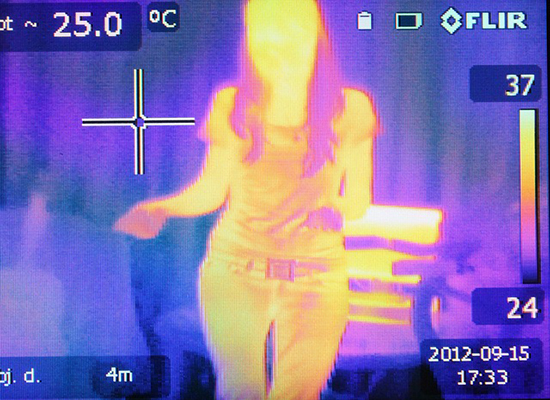


If you’ve ever felt unsafe walking to your car at night, infrared technology may be for you.
Using infrared (IR) in products is not new, but the push to have it in the consumer market is.
The FLIR One is one of the first infrared sensors aimed at the consumer market – the latest model costs $250 and plugs into an iPhone. With these types of devices, people can see living things in the dark by using their phone or by buying a car with IR features built in.
Many industries including military personnel, firefighters and renovators, to name a few, already use IR sensors to detect heat in places they cannot see.
But with the FLIR One sitting at $249.95 (CAN), it may be a bit too steep of a price for consumers to dive into. Especially if they don’t know how to use it properly.
“It’s very easy to pick up a camera and diagnose based on what you see,” says Jeremy Bartel, FLIR district sales manager for central Canada. “But it greatly helps to understand how that image is acquired.”
That’s why FLIR always prompts IR training because it’s important to comprehend the data if you’re willing to invest the money.
But it takes more than training to understand IR devices, there are many misconceptions about the technology.
A main one is that IR sensors can see through walls, windows and water – when, in fact, they cannot.
“Part of it is generated by Hollywood,” says Bartel. “The movie business has credited our [types of] cameras all the way back to the Predator movies.”
When using your IR sensor to detect overheating within a wall, you’re essentially seeing the affects of heat coming through to the surface. This is called thermal bridging.
But with the FLIR One effectively being able to capture heat prints, they are mainly advertised towards renovators and the average Joe. Using this smartphone attachable device, it could increase safety.

Their site claims it can help you find thermal insulation problems in your home, identify leaks before mold stars, spot overheating electrical connections and to ensure that your campfire is extinguished. Courtesy of FLIR Canada.
But smartphones aren’t the only consumer industry that is expected to start using IR more widely.
“I think there’s real commercial opportunity [in] automotive,” says Brian Benwell, program manager for the Life Science and X-ray program at Teledyne DALSA.
Teledyne DALSA designs, develops, manufactures, and markets digital imaging products and solutions and is a competitor of FLIR in terms of infrared products.
While having an infrared sensor on the front bumper of your car is already available in some high-end cars, eventually, it may become available for all cars.
This helps drivers see where people or animals are located in the dark. Benwell says he was hit by a deer while driving earlier this year and thinks it may have been prevented had he had an IR sensor.
There are two types of IR sensors for cars on the market. Active systems use infrared light to illuminate the roads at night whereas passive systems don’t use light but instead capture thermal radiation.
The cons of having an active system is that they don’t work well in fog or rain, they show a lower contrast for animals and they have a shorter range of about 150 to 200 metres. And right now manufactures like Mercedes-Benz and Toyota are the first to use it.
Passive systems on the other hand, have a great range of about 300 meters and they have a higher contrast for detecting living objects. But that’s just the silver-lining as the sensor gives a grainy, low resolution image and is also much larger in size. Manufactures like Audi, BMW and Honda are amongst the few that provide this in some of their models.
In some cars, the near-infrared sensors are said to prevent or soften impacts at speeds of 30km/h and lower by making the braking system stop faster when it detects an obstacle. But with the sensor only being able to detect obstacles up to six metres ahead, is that enough time to prevent an accident?
“It has its advantages and disadvantages,” says Kelly Gray, electronics technician in the School of Applied Technology at Humber College.
He says his friend who has a car with this capability had issues when the sensor was detecting snow as a barrier. The car then became difficult to maneuver because it frequently stopped due to the brakes being overly sensitive.
Aside from Gray not seeing infrared as a necessity, he does see it as a safer option.
“The more safety features they have the more safe the roads are,” he says.
But if IR sensors were included in all vehicles, the automotive industry would demand it at a low cost because of the hundreds of thousands of units that would be sold.
Even though many of the consumer IR sensors are advertised towards pro-sumers like industrial companies and renovators, the industry is working towards making the sensors more consumer-friendly. This would require sensors to become smaller, cheaper, longer lasting and more accessible.
“You have to get the price point of the sensor where you’re talking about something that’s a couple hundred dollars,” says Benwell. “The FLIR One is a novelty, but it’s not the same caliber.”
And with some of FLIR’s high-end cameras costing up to $30,000, the technology gap between high-end and the lower consumer end is still very large.
“A big win would be if someone could convince camera manufactures that infrared should be included,” says Benwell. “But that’s something the market would really have to demand.”
I guess you get what you pay for.






